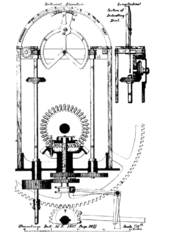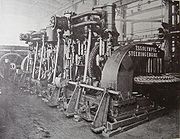
Steering engine
Encyclopedia


Steering
Steering is the term applied to the collection of components, linkages, etc. which will allow a vessel or vehicle to follow the desired course...
device for ship
Ship
Since the end of the age of sail a ship has been any large buoyant marine vessel. Ships are generally distinguished from boats based on size and cargo or passenger capacity. Ships are used on lakes, seas, and rivers for a variety of activities, such as the transport of people or goods, fishing,...
s.
History
The first steering engine with feedback was installed on Isambard Kingdom BrunelIsambard Kingdom Brunel
Isambard Kingdom Brunel, FRS , was a British civil engineer who built bridges and dockyards including the construction of the first major British railway, the Great Western Railway; a series of steamships, including the first propeller-driven transatlantic steamship; and numerous important bridges...
's SS Great Eastern
SS Great Eastern
SS Great Eastern was an iron sailing steam ship designed by Isambard Kingdom Brunel, and built by J. Scott Russell & Co. at Millwall on the River Thames, London. She was by far the largest ship ever built at the time of her 1858 launch, and had the capacity to carry 4,000 passengers around the...
in 1866.
This was a steam-powered mechanical amplifier used to drive the rudder
Rudder
A rudder is a device used to steer a ship, boat, submarine, hovercraft, aircraft or other conveyance that moves through a medium . On an aircraft the rudder is used primarily to counter adverse yaw and p-factor and is not the primary control used to turn the airplane...
position to match the wheel
Wheel
A wheel is a device that allows heavy objects to be moved easily through rotating on an axle through its center, facilitating movement or transportation while supporting a load, or performing labor in machines. Common examples found in transport applications. A wheel, together with an axle,...
position. The size of the Great Eastern, by far the largest ship of its day, made power steering a necessity.
Large steam-powered warships with manual steering needed huge crews to turn the rudder rapidly. The Royal Navy once used 78 men hauling on block and tackle
Block and tackle
A block and tackle is a system of two or more pulleys with a rope or cable threaded between them, usually used to lift or pull heavy loads.The pulleys are assembled together to form blocks so that one is fixed and one moves with the load...
gear to manually turn the rudder on the HMS Minotaur (1863)
HMS Minotaur (1863)
HMS Minotaur was the lead ship of the armoured frigates built for the Royal Navy during the 1860s. They were the longest single-screw warships ever built. Minotaur took nearly four years between her launching and commissioning because she was used for evaluations of her armament and different...
, in a test of manual vs. steam powered steering.
Steam-powered steering engines were employed on large steamships thereafter. The picture at the right shows the steering engine for the RMS Olympic
RMS Olympic
RMS Olympic was the lead ship of the Olympic-class ocean liners built for the White Star Line, which also included Titanic and Britannic...
, sister ship to the RMS Titanic.
The Mississippi River style steamboat Belle of Louisville
Belle of Louisville
The Belle of Louisville is a steamboat owned and operated by the city of Louisville, Kentucky and moored at its downtown wharf next to the Riverfront Plaza/Belvedere during its annual operational period...
, (originally the Idlewild and oldest in her class), is fitted with a steering engine. Original equipment when the boat was launched at Pittsburgh in 1915, the engine consists of a single double-acting steam cylinder mounted aft of and above the engines, coupled to the rudders, with the motion of travel abeam. The steam valves of the engine are controlled by mechanical linkages which extend up to levers mounted either side of the engine order telegraph, just aft of the pilot wheel in the pilot house above. The steering engine is open to public view. A functional description is given in the 1965 book Str. Belle of Louisville, by Alan L. Bates, the marine architect who supervised the restoration of the boat, who comments that when in use, the steering engine causes the pilot wheel to whirl "as fast as an electric fan." The same source also describes the functional need for steering hard-to in vessels of its type, whose combination of shallow draft and high above-water profile require rapid changes in rudder under shifting wind conditions, a need which is addressed by the steering engine.

